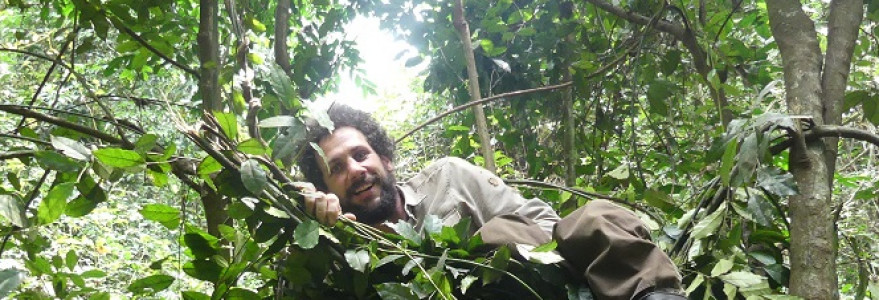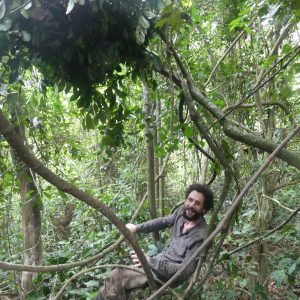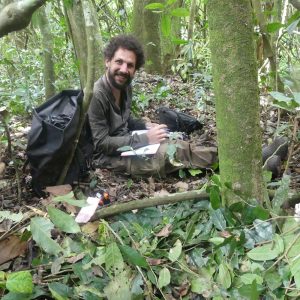A team of researchers from the Faculty of “Artes Liberales” at the University of Warsaw and the Institute for Biodiversity and Ecosystems Dynamics at the University of Amsterdam have conducted a study on the ground nesting of chimpanzees in the northern Democratic Republic of the Congo. The results are published in the prestigious journal “Folia Primatologica”.
The paper “Factors affecting nest height and ground nesting behaviour in Eastern chimpanzees of the northern Democratic Republic of the Congo” is the result of the research conducted by the scientists from the University of Warsaw and the University of Amsterdam. In the course of the study the researchers have found that chimpanzees nest on the ground even in areas where large carnivores are present, which has implications for the evolution of terrestriality in our own hominin ancestors. Human hunting, however, has a negative impact on ground nesting and a positive one on nest height.
The main author of the paper is Toni Romani of the Faculty of “Artes Liberales”, who is a doctoral candidate in the UW’s Nature-Culture program.
The main goal of the study was to achieve a better understanding of the factors that might have led our hominin ancestors to transition to a more terrestrial niche, including sleeping on the ground. Chimpanzees, like all other species of great apes, build nests in which they sleep each night. Until now, however, we have known little about regional differences in nesting habits of the chimpanzees.
Until recently, nesting on the ground was considered typical of gorillas, but appeared to be rare in most populations of chimpanzees. A team of researchers led by Dr Thurston C. Hicks, now at the UW’s Faculty of “Artes Liberales”, conducted an extensive chimpanzee nesting survey between 2004 and 2013 at 20 regions in the northern Democratic Republic of the Congo, where they found abundant ground nests across a >50,000 km² region. The acquired data enabled Romani, Hicks and colleagues to construct statistical models to investigate the factors promoting ground nesting in eastern chimpanzees.
Findings
The researchers found that ground nests made up more than 1% of total nests at 15 of the 20 survey regions. For a subset of 16 of these regions, they utilized statistical models to investigate whether forest type and structure, as well as the abundance of carnivores and large herbivores, and the activities of humans impacted the frequency of ground nesting and nest height. They also predicted that higher encounter rates of signs of humans and potentially dangerous carnivores and ungulates would be associated with lower rates of ground nesting as well as increased nest height. Overall, 10.4% of the Bili-Uéré chimpanzee nests were terrestrial, but the frequency of ground nesting varied extensively between the survey areas (0-29% of nests).
The occurrence of ground nests was positively associated with such factors as: denser forests, vine tangles, herb patches, and light gaps. Hunting by humans had a negative effect on likelihood of a nest being a ground nest and a positive one on nest height. In addition, the chimpanzees nested at significantly lower heights with increasing distance from roads and settlements. Interestingly, the researchers also discovered that carnivore encounter rates had no significant impact on ground nest frequency or nest height.
The authors demonstrate that ground nesting is a part of the most widespread chimpanzee behavioral realm known to science, that of Bili-Uéré. The results of the study indicate that ground nesting can no longer be considered a rare and patchily-occurring phenomenon in our close cousin Pan troglodytes, being a major component of the chimpanzee behavioural repertoire across a considerable fraction of the range of the Eastern subspecies. The study highlights that neither the large body size of gorillas nor the taming of fire are necessary conditions for hominids to sleep overnight on the ground, even in areas inhabited by multiple species of large carnivore. Human hunting, however, appears to reduce the probability of ground nesting, or eliminate the behaviour altogether.
Details of the paper
Romani, S. Tranquilli, P. Roessingh, S. B. J. Menken, R. Mundry, M. Konarzewski, T. C. Hicks, Factors affecting nest height and ground nesting behaviour in Eastern chimpanzees of the northern Democratic Republic of the Congo, Folia Primatologica, 0 (2023), 1-34, DOI: https://brill.com/view/journals/
The co-authors from the University of Warsaw are Dr Thurston C. Hicks and Prof. Marek Konarzewski.






